
Cowry shell. Shang-Zhou.
|
Coins
made of other materials than bronze |
Nearly all Chinese cast coins were bronze coins. Some call them copper coins, but they were actually bronze coins or copper alloys. However, materials other than bronze have also been used for coins: gold and silver has naturally been used for money, like it has in most other cultures, but also cowry shells, clay, bone, jade, iron, lead, tin, and bamboo have been used for money. Iron and lead was usually used because of shortage of copper.
|
Iron coins: Han, Three Kingdoms, North and South, Five dynasties and Ten Kingdoms, Song, Jin (1115-1234), Xi Xia, Ming and Qing. No iron coins: Shang, Zhou, Sui, Jin (265-420), Tang, Liao and Yuan.
Lead
coins: Zhou, Five dynasties and Ten Kingdoms, Northern Song* Silver coins:** Southern Song, and Qing.
Gold
coins: Yuanjin of Chu State in the Zhou period, Qin, Han, |
This is what is generally known at the present
time, but archaeological research will probably reveal that other periods used
alternative materials, at least in local areas.
* It is only recently that lead coins from the Song
have been discovered. Consequently, they are not listed in any catalogues,
but they are mentioned in Meng
Guohua: Guilin Faxian Qian Xi Hejin Qian. Zhongguo Qianbi No. 3. 1994
(Vol. 46.) and briefly in von Glahn p. 50.
** Uncoined silver bars in the shape of a saddle, called yuanbao, has been used in other periods, often in the shape of a shoe or a saddle.
Iron coins. The first iron coin was an iron Ban Liang from the early Han, and the last one was an iron coin made by emperor Xian Feng during the Taiping rebellion in the Qing dynasty. Two iron coins were usually worth one bronze coin. Due to a shortage of copper, many emperors tried to use iron to make coins, but as their subjects never took to them, most attempts were short-lived. Sometimes bronze coins had a certain amount of iron in them, but the iron was not mixed into the bronze, it was just not removed when the bronze was made. The mechanical strength was thus reduced because of this, but in the case of coins this was not as important as with tools (Wagner s. 131). Because of corrosion, iron coins are seldom in very good condition today, especially if they have been excavated.
Lead coins. Lead coins have only been cast a few times, mainly during the Five Dynasties period. Because of the softness of the metal, most lead coins found today are very worn.
The coins shown below are also placed under their respective dynasties.
Shang to Zhou

Cowry shell. Shang-Zhou.

Cowries from Shang-Zhou in bone and clay.

Jade cowry. Shang Zhou.
Warring States
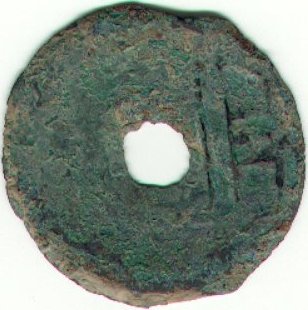
Warring States. Round hole coin with about 30% iron. Character Yuan ![]() .
.
Han dynasty


3,0 gr. 24 m.m.
Same type as above but iron. The earliest type of iron coin in China.
No
references in catalogues. Unearthed in Sichuan.


Ban Liang. 3,4 gr. 24 m.m.
Same type as above but Lead.
Unearthed in Xian, Shaanxi province.
Five dynasties and ten Kingdoms


Schjöth 433 Ding 775. Qian De Yuan Bao. Lead. Kingdom of Min. Reverse
"Min" and a dot.


Ding 827. Qian Heng Zhong Bao. Southern Han. Lead. Worth 1/10 bronze coin (Peng
p. 264).
Note that Zhong and Bao is read left-right.


Schjöth 436v/Ding 828. Qian Heng Zhong Bao. Southern Han. Lead.
Worth 1/10 bronze coin. Southern Han of 5 dynasties and ten states. Cast in
Guangdong.


Schjöth 448v. Ding 796. Chu state of 5+10. Qian Feng Quan Bao. Reverse Tian.
Iron. 18,02 gr.


Schjöth 460. Lead. Tai Ping Tong Bao. Circulated as substitute for
bronze.
Cast in Guangxi or Guangdong. 3,68 gr.


Schjöth 463. Lead. Shun Hua Yuan Bao. Cast in Guangxi or Guangdong. 4,68 gr.


Schjöth 465. Lead. Zhi Dao Yuan Bao. Cast in Guangxi or Guangdong. 4,69 gr.


Schjöth 469. Lead. Xian Ping Yuan Bao. Cast in Guangxi or Guangdong. 3,07 gr.
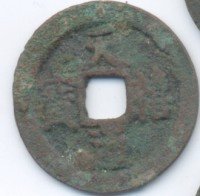
Schjöth 480. Tian Xi Tong Bao. Iron.
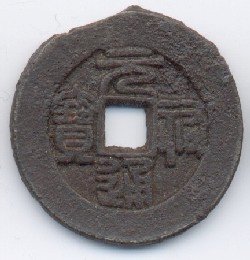
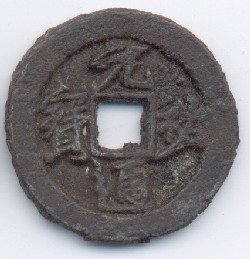
Schjöth 580. Yuan You Tong Bao. Iron. Schjöth
581. Yuan You Tong Bao. Iron.


Schjöth 597. Shao Sheng Yuan Bao. Iron.


Schjöth 598. Shao Sheng Yuan Bao. Iron.


Schjöth 622v. Chong Ning Zhong Bao. Iron.


Schjöth 627. Chong Ning Tong Bao. Iron.


Schjöth 632. Da Guan Tong Bao. Value 3 Iron.


Schjöth 632v. Da Guan Tong Bao. Value 2. Iron.


Schjöth 646. Zheng He Tong Bao. Iron.
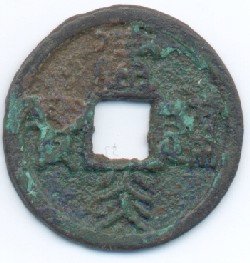
Schjöth 674v. Jian Yan Zhong Bao. Iron.
Southern Song
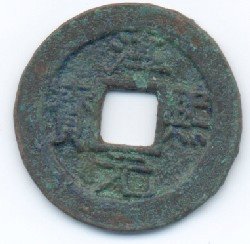
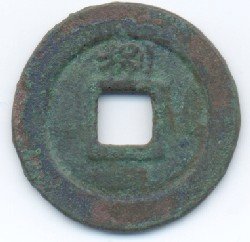
Schjöth 732v. Chun Xi Yuan Bao. Reverse "Ba". Iron.
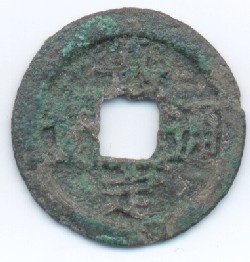

Schjöth 895v. Jia Ding Tong Bao. Iron.
Western Xia


Ding 1684. Tian Sheng Yuan Bao. Iron.


Schjöth 1080. Iron. Qian You Yuan Bao.
Jin

Schjöth 1092. Iron. Da Ding Tong Bao.
Qing


Xian Feng Tong Bao. Iron coin.
Krause 1801-1900. Empire, general issue s. 205. 1-4a. Iron coins were
issued by Xian Feng during the Taiping rebellion, because the war against the
rebels caused a shortage of cupper.

Temporary bamboo coin substitute from end of Qing.




Chinese porcelain gambling tokens used by the Chinese in Thailand.